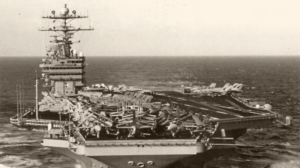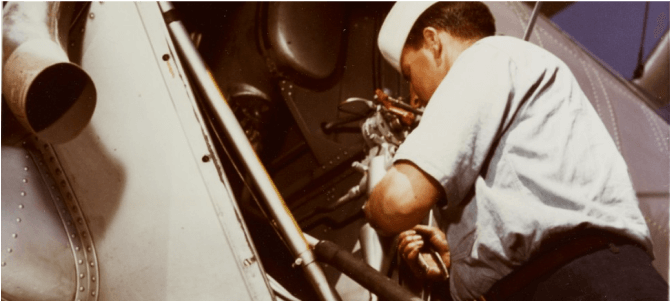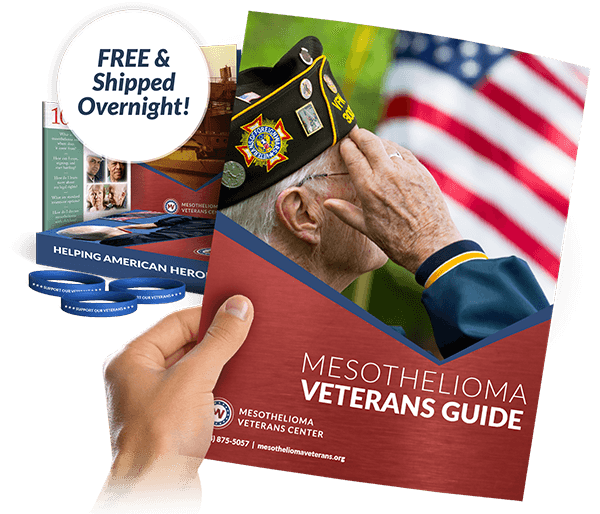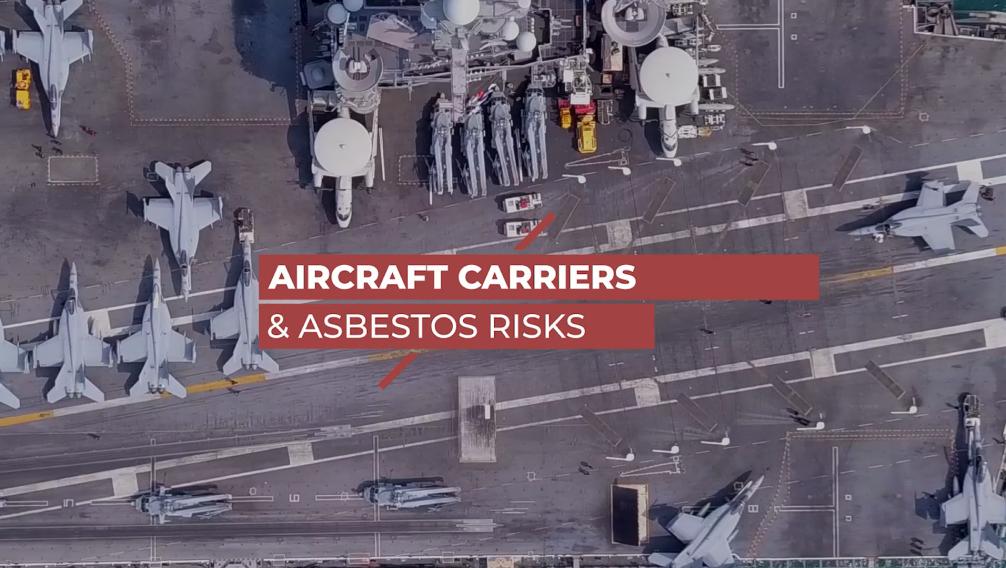Before the early 1980s, every U.S. Navy aircraft carrier was built with asbestos, a cancer-causing material. Veterans exposed to asbestos on aircraft carriers are now at risk of a cancer called mesothelioma. Our team can help you pursue military benefits, medical treatments, and legal compensation if you developed mesothelioma from serving on an aircraft carrier.
Aircraft Carriers and Mesothelioma Risks
The U.S. Navy used asbestos-containing products on all aircraft carriers built from the 1930s to the early 1980s. The government mandated the use of asbestos aboard all Navy vessels as it was cheap, fire-resistant, and a good insulator.

Navy personnel didn’t know asbestos could cause mesothelioma until millions had already been exposed. This is because private companies hid the dangers of asbestos to keep making money.
Asbestos-related diseases like mesothelioma take 10-50 years to develop, so veterans who served aboard aircraft carriers decades ago are still at risk today.
The Mesothelioma Veterans Center is here to assist any U.S. veterans or their loved ones harmed by asbestos on aircraft carriers.
Work with us to access benefits from the U.S. Department of Veterans Affairs (VA), care from top mesothelioma doctors and hospitals, and compensation if eligible. Get our Free Veterans Packet to see all the ways we may be able to help you.
List of Aircraft Carriers That Used Asbestos
More than 60 U.S. Navy aircraft carriers used asbestos-containing products.
These aircraft carriers included:
- USS Abraham Lincoln (CVN-72)
- USS America (CV-66)
- USS Antietam (CV-36)
- USS Bataan (CVL-29)
- USS Belleau Wood (CVL-24)
- USS Bennington (CV-20)
- USS Bon Homme Richard (CV-31)
- USS Boxer (CV-21)
- USS Bunker Hill (CV-17)
- USS Cabot (CVL-28)
- USS Carl Vinson (CVN-70)
- USS Constellation (CV-64)
- USS Coral Sea (CVB-43)
- USS Cowpens (CVL-25)
- USS Dwight D. Eisenhower (CVN-69)
- USS Enterprise (CV-6)
- USS Enterprise (CVN-65)
- USS Essex (CV-9)
- USS Forrestal (CV-59)
- USS Franklin (CV-13)
- USS Franklin D. Roosevelt (CVB-42)
- USS Hancock (CV-19)
- USS Hornet (CV-8)
- USS Hornet (CV-12)
- USS Independence (CVL-22)
- USS Independence (CV-62)
- USS Intrepid (CV-11)
- USS John F. Kennedy (CV-67)
- USS Kearsarge (CV-33)
- USS Kitty Hawk (CV-63)
- USS Lake Champlain (CV-39)
- USS Langley (CV-1)
- USS Langley (CVL-27)
- USS Lexington (CV-2)
- USS Lexington (CV-16)
- USS Leyte (CV-32)
- USS Midway (CVB-41)
- USS Monterey (CVL-26)
- USS Nimitz (CVN-68)
- USS Oriskany (CV-34)
- USS Philippine Sea (CV-47)
- USS Princeton (CVL-23)
- USS Princeton (CV-37)
- USS Randolph (CV-15)
- USS Ranger (CV-4)
- USS Ranger (CV-61)
- USS Reprisal (CV-35)
- USS Saipan (CVL-48)
- USS San Jacinto (CVL-30)
- USS Saratoga (CV-3)
- USS Saratoga (CV-60)
- USS Shangri-la (CV-38)
- USS Tarawa (CV-40)
- USS Theodore Roosevelt (CVN-71)
- USS Ticonderoga (CV-14)
- USS Valley Forge (CV-45)
- USS Wasp (CV-7)
- USS Wasp (CV-18)
- USS Wright (CVL-49)
- USS Yorktown (CV-5)
- USS Yorktown (CV-10)
Hundreds of other U.S. Navy ships also contained asbestos. You may have been exposed even if the vessel you served on is not listed above.
Who Was at Risk of Exposure to Asbestos on Aircraft Carriers?
Any Navy veterans who served on aircraft carriers before the early 1980s may have been exposed to asbestos.
Video Summary: U.S. Navy aircraft carriers relied on asbestos-containing products between the 1930s and early 1980s, putting those aboard at risk of mesothelioma. Call (877) 450-8973 for help if you served on a carrier. View Transcript
Between the 1930s and early 1980s, nearly all U.S. Navy aircraft carriers were built with a deadly substance called asbestos.
Asbestos was used as fireproofing and insulation aboard aircraft carriers before the risks were widely known.
Boilers, gaskets, piping, and many more aircraft products contained asbestos.
U.S. veterans exposed to asbestos aboard aircraft carriers decades ago are now at risk of a life-threatening cancer called mesothelioma.
This cancer develops 10-50 years after asbestos exposure.
Fortunately, veterans who have mesothelioma from serving on aircraft carriers and other vessels can get benefits from the U.S. Department of Veterans Affairs.
Top mesothelioma VA benefits include health care coverage, monthly financial payouts, and support for spouses and next of kin.
Private mesothelioma compensation is also available to help veterans cover their bills. Filing private claims won’t impact a veteran’s ability to get VA benefits.
If you or a loved one served on an aircraft carrier and now have mesothelioma, the Mesothelioma Veterans Center can help you file for VA benefits and private forms of financial compensation. Connect with us now to learn more.
As service members worked with asbestos products on aircraft carriers, microscopic fibers could have entered the air. Carriers weren’t well-ventilated, so asbestos fibers often stayed in the air for hours.
Anyone who breathed in or swallowed the fibers could develop mesothelioma later in life. Those at the highest risk of exposure worked directly with or near asbestos products as part of their jobs aboard the ships.
Jobs with a high risk of exposure to asbestos on aircraft carriers included:
- Aircraft mechanics
- Boilermakers
- Electricians
- Hull technicians
- Pipefitters
- Plumbers
For 20 years, Jim served as a boiler technician on several Navy ships, including the USS Independence. He was exposed to asbestos on this aircraft carrier as he worked. Later in life, Jim started to experience respiratory health problems and doctors diagnosed him with mesothelioma.
Asbestos Exposure in Shipyards
Navy shipyard personnel who built and repaired aircraft carriers and other ships also had a high risk of asbestos exposure.
The work done in Navy shipyards forced sailors to take out asbestos-containing products from ships and install new ones, frequently exposing them to asbestos fibers.
If you developed mesothelioma after serving on an aircraft carrier or working in a Navy shipyard, you may qualify for VA benefits. Our team can help you file for or increase your VA benefits — get started right now.
Products Containing Asbestos on Aircraft Carriers


More than 300 asbestos-containing products were used on older U.S. Navy ships like aircraft carriers. Navy veterans who installed, repaired, or replaced these parts may have been exposed to asbestos.
Learn about some of the most commonly used products below.
Boilers
Navy boilers were coated with asbestos-containing insulation. As the insulation wore out over time, asbestos fibers were released into the air.
Many boiler rooms were cramped and poorly ventilated. This meant that Navy boilermakers could have breathed in or swallowed asbestos fibers while working.
Pipe Insulation
Pipes that carried steam through aircraft carriers were covered in asbestos insulation, which was wrapped in a layer of felt and then covered with tar.
Pumps
Asbestos pumps helped control the ships’ air conditioning systems. Bilge pumps, which removed water that seeped into the carriers, were also coated with asbestos.
Valves
Valves, which controlled the flow of fluids and gasses on aircraft carriers, were made with asbestos to resist pressure and corrosion.
Other Asbestos-Containing Products
So many asbestos-based parts were used aboard Navy aircraft carriers that exposure was hard to avoid.
Asbestos could be found in:
- Adhesives
- Block insulation
- Cables
- Capacitors
- Deck covering materials
- Gaskets
- Grinders
- Packing materials
- Paneling
- Tubes
Where Was Asbestos on Aircraft Carriers?
Asbestos-containing products were found throughout U.S. aircraft carriers and other vessels built by the Navy.
Asbestos was used in:
- Boiler rooms
- Damage control rooms
- Engine rooms
- Navigation rooms
- Propulsion rooms
- Pump rooms
It wasn't just the aircraft carriers themselves that were built with asbestos. U.S. Navy and Air Force planes stored on these carriers also used asbestos products like brake pads and engine linings to reduce the risk of fires.
Does the Military Still Use Asbestos on Aircraft Carriers?
The Navy does not use asbestos when building new aircraft carriers or other ships today. Steps were also taken to remove asbestos-based products from naval ships once the mineral’s dangers were widely known.
That said, some older aircraft carriers may still contain asbestos today. It was not possible for the Navy to remove all of the asbestos since each ship contained tons of it.
Three aircraft carriers built with asbestos are still used by the Navy:
- USS Carl Vinson (CVN-70)
- USS Dwight D. Eisenhower (CVN-69)
- USS Nimitz (CVN-68)
Fortunately, the asbestos products still in use on these vessels are well-contained and don’t pose a risk to human health.
Compensation for Exposure to Asbestos on Aircraft Carriers
Veterans who developed mesothelioma after being exposed to asbestos on aircraft carriers are often eligible for financial compensation.
This compensation can help veterans cover medical expenses associated with their diagnosis and keep their families safe.
Eligible veterans can get compensation from:
VA Benefits
Veterans can access monthly disability compensation typically worth almost $4,000 a month in 2024, as well as free or low-cost medical care, with their VA benefits.
Mesothelioma Lawsuits
Lawsuits against asbestos companies award over $1 million on average. Veterans can still get VA benefits if they file a mesothelioma lawsuit.
Our legal partners have secured millions of dollars in settlements for Navy veterans who developed mesothelioma from exposure to asbestos on aircraft carriers.
Notable aircraft carrier mesothelioma settlements include:
- $4 million to a Massachusetts veteran who served on the USS Randolph
- $3.47 million to the loved ones of a Tennessee veteran who served on the USS San Jacinto
- $3.42 million for a veteran who was stationed on the USS Enterprise and USS Canal
- $3.37 million to an Idaho veteran who was aboard the USS Wasp
- $3.17 million for a Georgia veteran who worked in the USS Essex's engine room
We may be able to help you or a loved one secure compensation too. Call (877) 450-8973 now.
Asbestos Trust Fund Claims
Trust funds were set up by asbestos companies that went bankrupt to avoid facing lawsuits. Asbestos trust funds contain over $30 billion today.
Trust fund claims allow veterans to access some of this money.
Our team may be able to help you access VA benefits, lawsuit compensation, and trust fund money if you were harmed by asbestos on aircraft carriers. Get started with our Free Veterans Packet.
We Can Help Veterans Exposed to Asbestos on Aircraft Carriers
U.S. Navy veterans who served aboard aircraft carriers and other ships put their lives on the line to defend our country. These brave veterans don’t deserve to suffer from mesothelioma and other asbestos-related diseases.
The Mesothelioma Veterans Center is available to help you or a U.S. veteran you love in any way we can.
Our team can help you:
- File or increase your mesothelioma VA benefits
- Find top doctors and hospitals in the VA’s network
- Seek compensation from lawsuits and trust fund claims
You served your country with dignity and pride — now let us serve you. Get started with a Free Veterans Packet or by calling (877) 450-8973 to speak with a member of our team.
FAQs About Aircraft Carriers and Mesothelioma
Do aircraft carriers have asbestos?
Yes, many aircraft carriers had asbestos aboard. Approximately 60 Navy aircraft carriers contained asbestos-containing products up through the early 1980s.
After the risks of asbestos came to light, the Navy no longer used this substance to build aircraft carriers or other ships.
Still, it’s believed that millions of veterans were exposed to asbestos on aircraft carriers and other ships before the risks were well-known.
Did the USS America have asbestos?
Yes, the USS America (CV-66) was built with asbestos-containing materials. If you served aboard this ship, you may have been exposed to asbestos and could be at risk of mesothelioma today.
Our team can find out when and how you were exposed to asbestos on aircraft carriers like the USS America. Call (877) 450-8973 now.
When was asbestos used on aircraft carriers?
Asbestos was used on aircraft carriers from the 1930s to the early 1980s due to government mandates.
At the time, asbestos was thought to be a safe substance as makers of asbestos-based products hid the dangers of this mineral from the public.
When was asbestos banned on ships?
The U.S. Navy stopped using asbestos aboard aircraft carriers and other vessels in the early 1980s. Older Navy ships also were refurbished, with most of the asbestos-containing products aboard removed.
That said, a full asbestos ban was never put into place in the U.S. A handful of older Navy aircraft carriers may still have asbestos products aboard today.
In these cases, though, the products are unlikely to pose a high risk of exposure since they are probably sturdy.
Is the USS Nimitz asbestos exposure?
Yes, you may have been exposed to asbestos on the USS Nimitz.
Asbestos-containing products aboard the USS Nimitz include insulation and gaskets.



